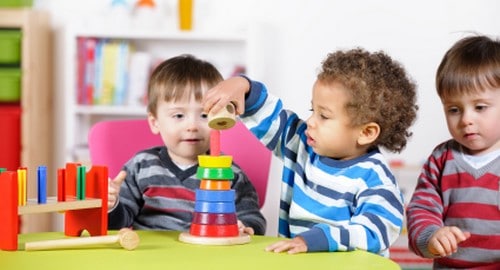
When you think of toddlers what comes to mind? Is it their tantrums? Could it be their innocent mischief – like when they unraveled all of the toilet paper rolls they could find? Is it their fascination with simple joys – big belly giggles, wide opened wonder, and squeals over common life?
It would appear that teaching to toddlers would be a no-brainer, right? I mean, we’re talking children from between 12 months and 36 months of age. They’ve graduated from the baby stage, so how hard could it be? It only takes one hour to find out.
Upon closer inspection (on the job training!), teachers may find toddlers to be busy, fiercely independent, unable to communicate articulately, emotional, curious, active, and messy. One toddler is usually exhausting, never mind a room of them! So how does one keep a toddler aged child happy and safe and engaged and learning?
Here are some tips for teaching to one of the most unique developmental brackets of childhood:
1. Create or Adapt the Environment
A safe, age-appropriate classroom that encourages exploration and learning is the foundation from which to begin. Toddler environments should include: a central group area, a quiet cozy “safe corner” with board books, a gross motor area with mats and wide open spaces for ride on toys and push toys, a block area with large blocks and trucks, a dramatic play center including pretend play items and mirrors, and a sensory station with a rotating sensory table (filled with containers, measuring cups, and rice, pasta, scarves, water, sand, instruments, etc.). Use pictures in each center to facilitate learning. Ensure that all of the toys are age-appropriate (and not choking hazards) and swap out toys on a regular basis. In a perfect setting, younger toddlers (12-24 months) should be separated from older toddlers (24-36 months) because there is such a wide variance of developmental abilities between the two.
In addition, consider the layout of the furniture to include organizational cubbies or bins and hooks for individual storage, low child sized tables and chairs, a diaper changing station, gliders for rocking, snack and drink storage, and an art supply and display area. As always, check with state guidelines to ensure that your church classroom is meeting the minimum guidelines for toddler spaces. Ensure that your toddler room meets the designated ratio of adults to children. Have an immediate way to contact the parent in case of emergency. Ensure that you have up to date records on each child in your care. Also, have a regular plan (checklist) for cleaning the facility, equipment, and toys to ensure that the environment is sanitary.
2. Provide Age-Appropriate Lesson Plans
When writing lesson plans for toddlers, find a classroom routine that works for you and stick with it. Toddlers thrive on routines! Incorporate a considerable amount of “free play” into your lesson. Remember that children learn through play, so begin and end your time spent together with it. Stick to a simple lesson such as “God Made Me” or “Jesus Loves” or “Right and Wrong.” Include elements of your lesson around the room in each center, if applicable. Be present during free play, observing students and engaging them in learning, asking questions, and problem solving.
In your planning, include songs and finger plays, simple books with little text and rich images, common everyday pictures as visuals, simple adapted games (Ring Around the Rosy, Red Light Green Light, Head Shoulders, Knees and Toes, Hide and Seek with items, etc.), movements to music, creative role-playing and imaginative play (for the older toddlers), and art exploration.
3. Interact with Toddlers at Their Level
Speak with a toddler at their eye level. Be clear and concise in your language and directions. Help them to verbalize what they are doing, as if you are narrating a scene or commentating for a sporting event. Be prepared with a tantrum response plan. Toddlers crave a sense of independence, so give them occasional choices, but limit them to two. (Would you like green or red paint?) Empower older toddlers by giving them small helping roles. (Pass out the napkins.) Help toddlers feel secure with your kindness, presence, consistency, and prayer.
When speaking to a group of toddlers, be on stage! Be as expressive as an actor or actress. Move around and allow them to do the same – a lot! Teach using a variety of methods to appeal to their senses and unique learning modes. Vary the sound of your own voice. Dress up, be silly, laugh a lot, and love! Have fun with your toddlers! Allow them to teach you how to be a child again.
4. Get to Know their Caregivers
Caregivers already have a measure of trust in you, otherwise they would not be willing to leave their child in your care. However, make connections with them. Ask questions and listen carefully. Provide them with ways that they can help in the classroom, so they feel connected. Create a simple take home handout for them, summarizing the lesson and giving them opportunities to extend the learning at home. Specifically write in what their child did in class that day. Observe developmental changes in the child and communicate your excitement and observations. (When did Alex learn to walk? I love how Sophia is using her words to communicate! Adam and Ben were playing side by side today in the block center.) Encourage the parent at every opportunity. Be available and humble. Allow them ways to express feedback. Make it a point to individually pray for each toddler and parent in your ministry.
Clearly, this list is not all encompassing! What are some of your favorite tips and techniques for working with toddlers?
